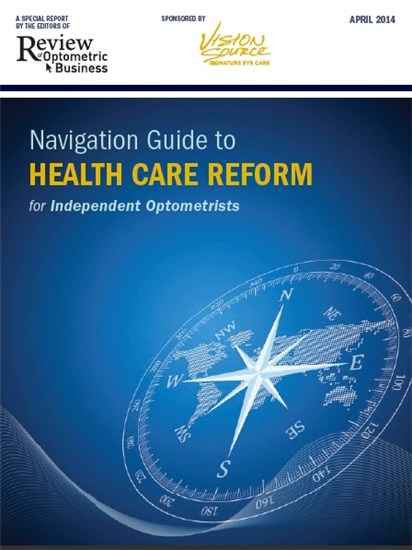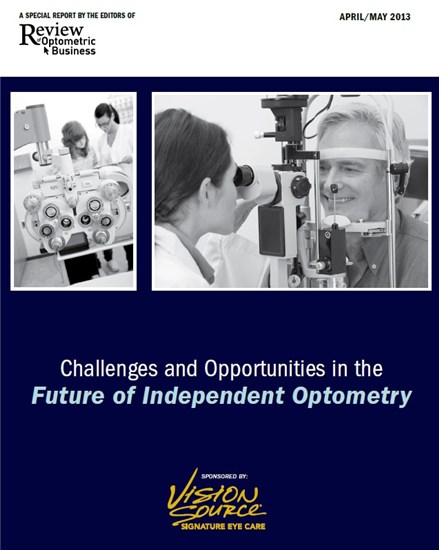By ROB Editors
Vision Source commissioned Review of Optometric Business to create “Navigation Guide to Health Care Reform for Independent Optometrists,” a report summarizing important trends in US health care delivery and what they mean for independent optometrists. Included in the report are strategy imperatives and action plans.
 This is the second article in a three-part series.
This is the second article in a three-part series.
CLICK HERE or on the image to the left to download the full report,published in April 2014.
Independent optometrists are well positioned to capture growth opportunities in this era of health care reform. To do so, optometrists must understand changing market dynamics, then reorient their practices in response to these changes.
Consolidation and institutionalization of primary care physicians
The Affordable Care Act is likely to accelerate consolidation, and the independent practice physician will gradually disappear. The economics of medical practice in an environment dominated by third-party payers favor larger medical groups able to negotiate reimbursements, manage information technology and keep current with regulations and rules. This will erode many long-standing referral arrangements between individual PCPs and ODs, as large MD groups seek arrangements with OD provider panels which can service a wide geographic area with consistently high standards.
The same forces causing consolidation among physicians will make the financial well-being of solo optometric practices increasingly precarious and will encourage more formation of group practices and membership in OD alliances, such as Vision Source.
Growing shortage of primary care physicians
A major consequence of a physician shortage is that primary care physicians will use a greater portion of their workday seeing patients with more acute and complex conditions, and less time tending to patients with uncomplicated chronic diseases, minor disorders, prevention and counseling. Increasingly, these less complicated medical tasks and responsibilities will be delegated to non-MD clinicians, including physician assistants, and potentially, to optometrists.
For optometrists, the primary care physician shortage is likely to mean that insurance companies will increasingly direct patients to optometrists to monitor diabetes and glaucoma, for regular eye exams and to provide other medical eyecare services. Primary care physicians will also be more likely to refer patients to ODs for routine testing. The effect will be to expand the role of optometrists in American health care.
Action Plan
Refine office processes to serve diabetic and glaucoma patients.
Each optometric office will need to be equipped with instrumentation to monitor diabetes and glaucoma, including retinal imaging, OCT and visual fields.
OD offices will need to establish methods to pre-appoint diabetics and patients with high glaucoma risk to assure that annual exams are performed and insurer standards are met.
Procedures must be developed to issue succinct reports to primary care physicians on the day patients are examined. Staff must be trained to educate patients about compliance with annual exams and about chronic diseases. Procedures must be put in place to remind patients of scheduled exams.
Reorient practice to provide pediatric vision benefits.
Most medical plans are expected to include a pediatric vision benefit. Procedures should be put in place to educate parents about these benefits. In many practices it will be necessary to educate the doctor and staff to communicate effectively with youth and to demonstrate the practice’s enthusiasm for treating young patients.
If not currently a Medicaid provider, reconsider participation.
Medicaid expansion should trigger reconsideration of Medicaid participation. Because Medicaid now covers people up to 133 percent of the federal poverty level, it may now cover a larger portion of a practice’s population. For example, under the new law for a family of five, Medicaid expansion covers up to a family income of $36,668.
>>Click HERE to view resources on expanded Medicaid coverage>>
If the practice is already a Medicaid provider, prepare the office for more Medicaid patients filling your schedule.
RELATED ARTICLE
Major Implications of Health Care Reform–for Independent ODs
 RELATED REPORT
RELATED REPORT
Challenges and Opportunities in the Future of Independent Optometry



























